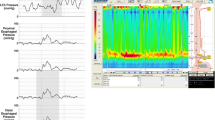Abstract
The changes in esophageal motility after pneumatic dilatation were evaluated prospectively in 51 patients with achalasia. The patients were evaluated for a median of 14 months. Pneumatic dilatation led to a clinical improvement in 41 patients. On manometric evaluation, a significant decrease in lower esophageal sphincter pressure was observed (28.4±14.9 mmHg vs. 13.5±7.2 mmHg; p=0.001); the resting pressure of the esophageal body dropped from 4.8±4.2 mmHg above gastric baseline to 0.1±3.9 mmHg below gastric baseline. After therapy, peristaltic activity was present in 10/51 (20%) patients; in 1 case, complete relaxation of the lower esophageal sphincter was recorded. Treatment-induced motility changes could not be predicted by clinical history or the lower esophageal sphincter pressure before or after therapy. However, the resting pressure of the esophageal body before and after therapy was significantly lower in these patients in whom peristalsis recurred after therapy than in patients with an unchanged motility pattern. The reappearance of peristaltic activity after pneumatic dilatation was unrelated to lower esophageal sphincter pressure. In conclusion, motility disturbances of the esophageal body in patients with achalasia do not simply reflect the functional obstruction of the lower esophageal sphincter. These findings support the hypothesis that achalasia is not a distinct motility disturbance but should be regarded as part of a broad spectrum of different interrelated esophageal motility disorders.
Similar content being viewed by others
References
Vantrappen G, Hellemans J: Treatment of achalasia and related motor disorders.Gastroenterology 79:144–154, 1980
Wienbeck M, Berges W, Frieling T: Therapeutic advances in oesophageal motility disorders.Balliere's Clin Gastroenterol 1:857–867, 1987
Bianco A, Cagossi M, Scrimieri D, Greco AV: Appearance of esophageal peristalsis in treated idiopathic achalasia.Dig Dis Sci 31:40–48, 1986
Csendes A, Braghetto I, Henriquez A, Cortes C: Late results of a prospective randomised study comparing forceful dilatation and oesophagomyotomy in patients with achalasia.Gut 30:299–304, 1989
Lamet M, Fleshler B, Achkar E: Return of peristalsis in achalasia after pneumatic dilatation.Am J Gastroenterol 80:602–604, 1985
Mellow MH: Return of esophageal peristalsis in idiopathic achalasia.Gastroenterology 70:1148–1151, 1976
Ponce J, Miralbes M, Garrigues V, Berenguer J: Return of esophageal peristalsis after Heller's myotomy for idiopathic achalasia.Dig Dis Sci 31:545–547, 1986
J Miralbes M, Garrigues V, Berenguer J: Return of esophageal peristalsis after Heller's myotomy for idiopathic achalasia.Dig Dis Sci 31:545–547, 1986
Vantrappen G, Janssens J, Hellemans J, Coremans G: Achalasia, diffuse esophageal spasm, and related motility disorders.Gastroenterology 76:450–457, 1979
Katz PO, Richter JE, Cowan R, Castell DO: Apparent complete lower esophageal sphincter relaxation in achalasia.Gastroenterology 90:978–983, 1986
Ott DJ, Richter JE, Chen YM, Wu WC, Gelfand DW, Castell DO: Radiographic and manometric correlation in achalasia with apparent relaxation of the lower esophageal sphincter.Gastrointest Radiol 14:1–5, 1989
Smith B: The neurological lesion in achalasia of the cardia.Gut 11:388–391, 1970
Reynolds JC, Parkman HP: Achalasia.Gastroenterol Clin North Am 18:223–255, 1989
Schulze-Delrieu K, Shirazi S, Sprunger K, Noel S, Tung H: Functional denervation of the esophagus from experimental obstruction.Gastroenterology 94:A414, 1988
Berges W, Stolze T, Wienbeck M: Diagnostic problems in the differentiation of achalasia and spasm of the oesophagus.Z Gastroenterol 18:365–369, 1980
Hogan WJ, Calfisch CF, Winship DH: Unclassified ocsophageal motor disorders simulating achalasia.Gut 10:234–240, 1969
Kaye MD: Dysfunction of the lower esophageal sphincter in disorders other than achalasia.Dig Dis 18:734–744, 1973
Kramer P, Harris LD, Donaldson RM: Transition from symptomatic diffuse spasm to cardiospasm.Gut 8:115–119, 1967
Author information
Authors and Affiliations
Rights and permissions
About this article
Cite this article
Bielefeldt, K., Enck, P. & Erckenbrecht, J.F. Motility changes in primary achalasia following pneumatic dilatation. Dysphagia 5, 152–158 (1990). https://doi.org/10.1007/BF02412639
Issue Date:
DOI: https://doi.org/10.1007/BF02412639




